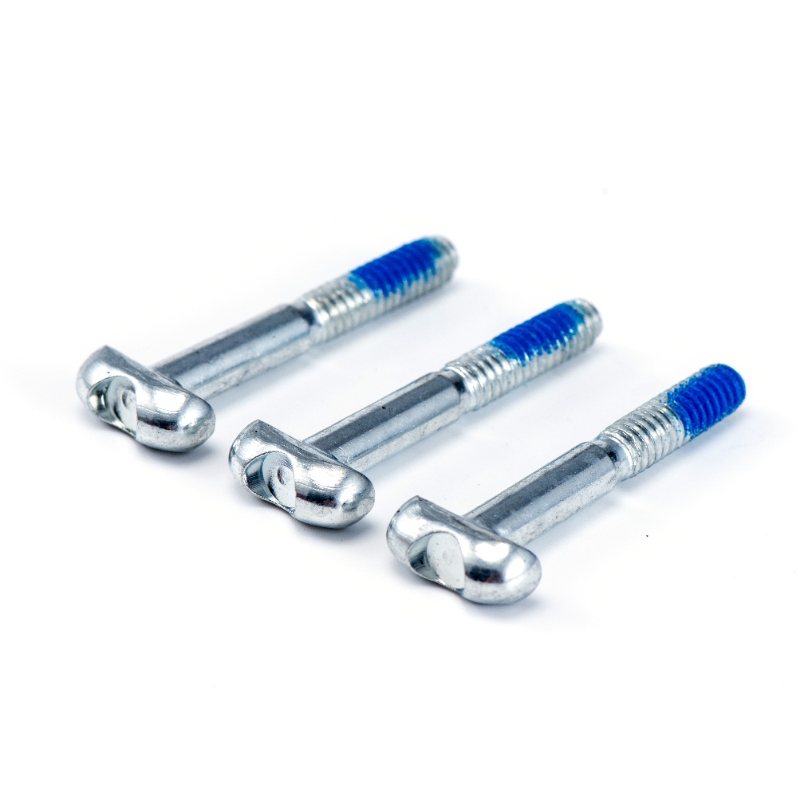T-Screws: Features, Applications, and Maintenance
T-Screws, also known as T-slot screws or T-Bolts, are specialized Fasteners designed for use with T-slot tracks or channels. These screws feature a unique T-shaped head that slides into the T-slot, allowing for secure and adjustable clamping in various industrial and mechanical applications. The design ensures high load-bearing capacity while providing flexibility in positioning.

Key Features of T-Screws
1. High Tensile Strength: T-Screws are typically manufactured from high-grade steel (e.g., Grade 8.8 or 10.9), offering tensile strengths ranging from 800 MPa to 1000 MPa. This ensures reliable performance under heavy loads and vibrations.
2. Precision Machining: The T-head is precision-machined to fit standard T-slot dimensions (e.g., 8mm, 10mm, or 12mm slots) with tolerances as tight as ±0.05mm for optimal engagement and minimal play.
3. Corrosion Resistance: Many T-Screws feature zinc plating (5-15µm thickness) or stainless steel construction (A2 or A4 grade) for corrosion resistance in harsh environments.
4. Load Capacity: Depending on size and material, T-Screws can withstand static loads up to 20 kN and dynamic loads up to 5 kN in typical applications.
5. Temperature Range: Standard steel T-Screws operate effectively between -50°C to +150°C, while stainless steel variants can handle -200°C to +400°C.
Applications of T-Screws
1. Machine Tools: T-Screws are extensively used in CNC machines, milling machines, and lathes for securing workpieces to T-slot tables. Their precise positioning allows for accurate machining operations.
2. Industrial Automation: In robotic workstations and assembly lines, T-Screws provide modular fixturing solutions with positioning repeatability of ±0.1mm.
3. Automotive Jigs: Vehicle manufacturing utilizes T-Screws in welding and assembly jigs where quick adjustments are needed (typical torque values of 20-50 Nm).
4. Aerospace Tooling: For aircraft component fabrication, T-Screws offer vibration-resistant clamping (withstanding frequencies up to 200 Hz).
5. Woodworking: In router tables and workbenches, T-Screws enable secure hold-downs for materials during cutting operations.
Maintenance Procedures
1. Cleaning: Regularly remove debris from T-slots using compressed air (at 2-3 bar pressure) and clean screw threads with a wire brush (stainless steel, 0.2mm bristle diameter recommended).
2. Lubrication: Apply dry-film lubricant (e.g., PTFE-based, 10-20µm coating) to threads every 500 operating hours or when friction increases beyond 0.15 coefficient.
3. Inspection: Check for wear every 6 months using go/no-go gauges. Replace screws showing more than 0.1mm of head deformation or thread damage.
4. Torque Monitoring: Use calibrated torque wrenches (±3% accuracy) to maintain proper clamping force, typically 70-80% of proof load (e.g., 35 Nm for M10 Grade 8.8 screws).
5. Corrosion Prevention: In humid environments, apply corrosion inhibitor (VCI emitters with 5g/m³ concentration) to storage areas.
Installation Best Practices
1. Alignment: Ensure T-head is properly seated in the slot (gap <0.1mm) before tightening to prevent uneven stress distribution.
2. Tightening Sequence: When using multiple screws, follow a star pattern tightening sequence with incremental torque steps (25%, 50%, 75%, 100% of final torque).
3. Washer Use: Always use hardened washers (HRC 40-45) under the nut to distribute load and prevent slot deformation.
4. Thread Engagement: Maintain minimum 1.5 times screw diameter of thread engagement (e.g., 15mm for M10 screw).
5. Vibration Prevention: For dynamic applications, use prevailing torque nuts (e.g., nylon insert) or thread-locking compounds (medium strength, 10 Nm breakaway torque).
Common Failure Modes
1. Fatigue Fracture: Typically occurs after 10⁶-10⁷ cycles at 50% of ultimate tensile strength. Detectable via magnetic particle inspection.
2. Thread Galling: Common in stainless steel screws; prevent by using anti-seize compound (60% nickel content recommended).
3. Corrosion Pitting: Visible as >0.3mm deep pits; accelerates stress concentration (Kt factor >3).
4. Head Deformation: Occurs when exceeding 80% of material yield strength (e.g., 640 MPa for Grade 8.8).
5. Slot Wear: Measurable as >0.5mm slot width increase from original dimensions.





